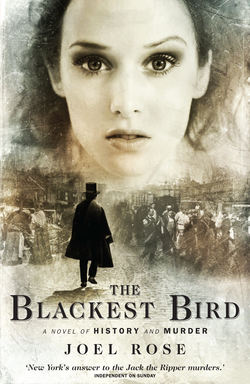Читать книгу The Blackest Bird - Joel Rose - Страница 26
На сайте Литреса книга снята с продажи.
Оглавление12
Death of the Corkcutter Daniel Payne
The killing of Samuel Adams by John Colt succeeded, finally, in driving the murder of Mary Rogers off the front page.
BODY FOUND IN BOX
There was no question of Colt’s guilt. Here was his confession in full, printed word for word in the Herald.
The rest of the penny papers were left to scramble, taking up mere points of law, exemplified by cogitation in that weekend’s Tattler:
PREMEDITATED MURDER OR SELF DEFENSE?
The answer presumably to this curious legal conundrum would dictate whether “Homicide Colt,” as the headline writers had come to call him, would live or die.
And so with this debate ongoing, public opinion found itself thusly consumed, until three weeks later, the sixth day of October, when all reverted once more to Mary Rogers.
On that afternoon Mary’s betrothed, the forlorn corkcutter Daniel Payne, haggard and worn, appeared at Mrs. Loss’s roadside inn, the Nick Moore House.
As reported by Bennett on the front page of the New York Herald:
Mr. Payne stood in the establishment and inquired of Mrs. Loss the exact location of the spot where Miss Rogers had met her death.
The unhappy man then sat down and commenced to drink a number of brandies before stumbling out.
Two days later Payne was discovered, an apparent suicide, on what was believed to be the exact spot of Mary Rogers’ murder, in the same small clearing where Mrs. Loss’s two sons, Oscar and Ossian, had found the scattered articles of her person, leading many to speculate, even conclude, that the corkcutter was guilty of his intended’s murder.
Others besides Mrs. Loss had seen Mr. Payne drinking and wandering about the general area.
Mr. Samuel Whitney, a patron of the Phoenix Hotel, told how Mr. Payne had appeared at the hotel bar late the night following Mrs. Loss’s encounter with him at the Nick Moore House.
“He looked red and a little intoxicated,” Mr. Whitney said. “And he seemed weak and could hardly stand up.”
During the course of the evening, Mr. Whitney further reported, Mr. Payne spoke to him in the following manner:
“Suppose you know me? Well, I’m the man who was to have been mar ried to Mary Rogers.”
Mr. Whitney said Mr. Payne then mumbled, “I’m a man of a good deal of trouble.”
An empty and shattered bottle of laudanum from the Deluc Chemist on Nassau Street, only steps from the Rogerses’ home, was found near the body. The Hoboken police were quickly notified of the death and forwarded immediate word to High Constable Hays in New York City.
A storm rose up early that evening. Hays, with Acting Mayor Purdy, who again insisted on inviting himself to accompany the high constable and Sergeant McArdel of the Night Watch, rode over in a small boat through the squall to investigate.
Upon their arrival, wet and chilled, the high constable was handed a note found by Dr. Cook in the dead man’s pocket. It was addressed:
TO THE WORLD
“Here I am on the spot,” Payne had written in a clear if not strong hand. “God forgive me for my misfortune in my misspent time.”
“He has died as the result of congestion of the brain, brought about by irregular living, exposure, and aberration of the mind,” Dr. Cook responded to questions posed to him by High Constable Hays pertaining to the exact cause of death.
Hearing this, the acting mayor let out an unsettling, self-satisfied yelp, proclaiming to one and all, with the death by his own hand of the corkcutter Daniel Payne, the mystery of the murder of Mary Rogers was solved, the murderer unmasked, the puzzle complete.
“Obviously, the young man had been rebuffed by the segar girl,” Purdy lorded. “My friends, it is the only explanation that need be drawn,” he continued with his pontification. “Mr. Payne, in what can singularly be called a fury of rejection, commenced then to throttle her, and abuse her in a violent, intimate manner. He then proceeded to murder her on the spot of the very clearing where he himself has now died by his own hand. Warranted by every observation, here lies our culprit.”
Hays paid silent attention to this smugly delivered conclusion, fixing first the invidious acting mayor, then Coroner Cook, with his famous steady, cold gaze before declaring:
“Not so, gentlemen. I have made life study of the police science of physiognomy. Daniel Payne was not one to escape my scrutiny. He is not our man.”
